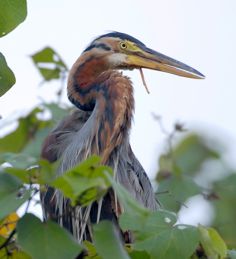On two separate occasions, Dr Chua Ee Kiam encountered an injured Purple Heron (Ardea purpurea) at the Sungei Buloh Wetland Reserve:
“I managed some shots of this Purple Heron on two occasions and I thought that something had pierced its lower jaw until a frontal shot of it opening its mouth revealed that its lower jaw was torn (pierced and torn by a wriggling catfish’s spines?) and a flap of tissue dangled from its lower jaw. This is like a patient having its trachea cut to allow him to breathe.”
Birds that feed on fish like Black Bittern (Ixobrychus flavicollis), Stork-billed Kingfisher (Halcyon capensis) and Great-billed Heron (Ardea sumatrana) need to knock off the fish and then position it in such a way that it can be swallowed head first. This will ensure that the spines will not damage the birds’ throat.
In the case of this Purple Heron, it is possible that it was trying to swallow a catfish, as suggested by Ee Kiam. The strong, sometimes serrated dorsal and pectoral spines can tear a bird’s throat as seen here if, not handled correctly.
Kelvin P K Lim of the Raffles Museum of Biodivertsity Research, National University of Singapore has this to say: “I think that heron must’ve been really careless to have been damaged this way. I’ve seen pictures and footage of herons eating large catfish, and it must be a very common food item for them. However, this is the first time I’ve seen a picture of a heron with a torn throat. Catfish spines are really strong and thick and I believe they can cause that kind of damage, but I really cannot confirm if the bird in the picture was hurt by a catfish.”
Input and images by Dr Chua Ee Kiam, additional input by Kelvin P K Lim.











7 Responses
The last I saw this bird at SBWR, was on 8th November 2007, alive and well.
Cheers
K C Tsang
That’s good news. Ee Kiam sent the report in mid-October, that means the heron has survived for at least a months, if not longer. Hope birders keep on monitoring its presence in the reserve.
Hi…
Mr Bird Lover
One’s love is another’s Enemy!!
Well.. let me tell you this story.
I stay in Telok Blangah Drive, and in between Blk 50 and 51, EVERY single morning.. without fail, there is this Black bird, with nice tail and all.. will be on top of his voice. Its Piercing LOUD.
I think its a rare bird and when it starts singing, other birds(yellow in colour) will follow. About 5 of them.
I deduce tat, it might be because of the reconstruction of the bridge in mount faber that had force them to migrate.
Would you be so Kind to capture them as i am now suffering from a lack of sleep.
Everyday i just dream of how to KILL the darn bird and his friends. I have also asked town council to come cut down the branches. ACT fast !!
Once, there were kampongs in Singapore where people kept chickens. The cockerals used to crow loudly early morning and we used to wake up with their calls. Did anyone call for these birds to be strangled? So what is wrong with an an Asian Koel’s early morning call, joined by those of the Black-naped Orioles? Can we not instead enjoy the calls? The birds were there before us – we have in fact taken over their habitats. Do we need to kill the bird and/or remove the trees just because of one bird? If the tree is chopped down, will we then complain that the place is hot in the afternoons? Do you want to live in a Singapore where there are no trees, no birds and only people in high rise apartment buildings? Can we not live and let live?
There are a few houses here in Seletar Airbase that still have chicken 🙂 YC, I agree with you, birdsong is one of the few joys still available for free. We sometimes get rowdy kingfishers – they have a lot to say!
My house has many birds: Asian Koels, Black-Naped Orioles, Oriental White-eyes, Collared Kingfishers, Scarlet-backed Flowerpeckers, Olive-backed Sunbirds, Common Ioras . & their bird songs in the morning is beautiful. & I sure don find their morning songs irritating when I get to sleep late. I don even hear them when I’m sleeping.
I would think that those that gets easily affected by calls of Asian Koel & Black-Naped Orioles need to get in touch with their inner peace. It is the soul which is not at peace that is causing the frustration.
Thanks Serene. Well said.